
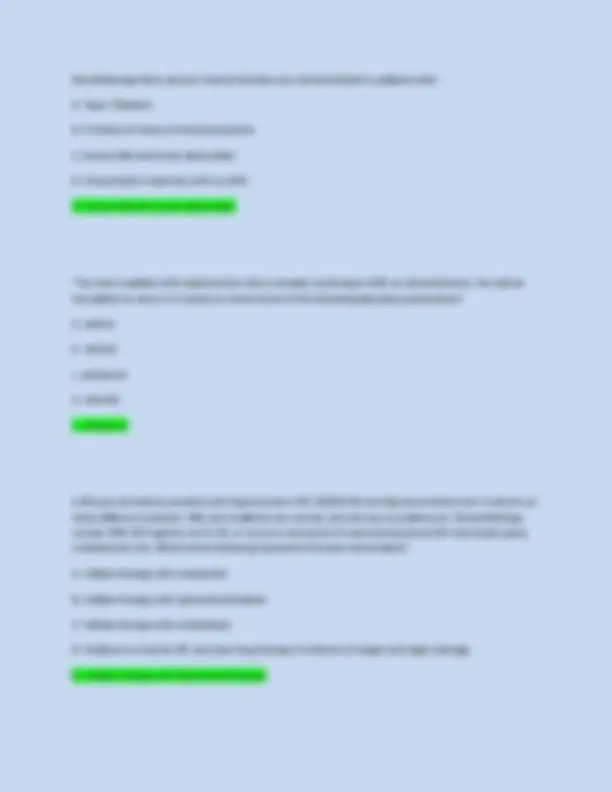
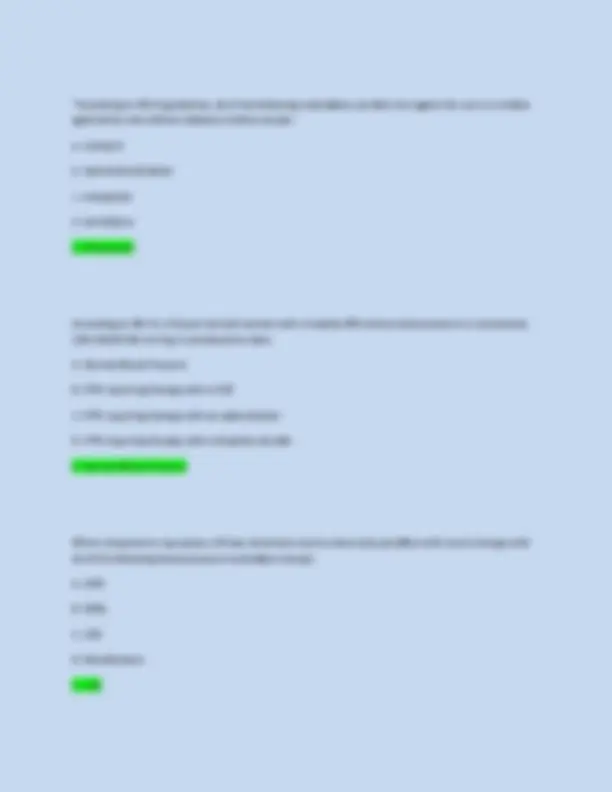
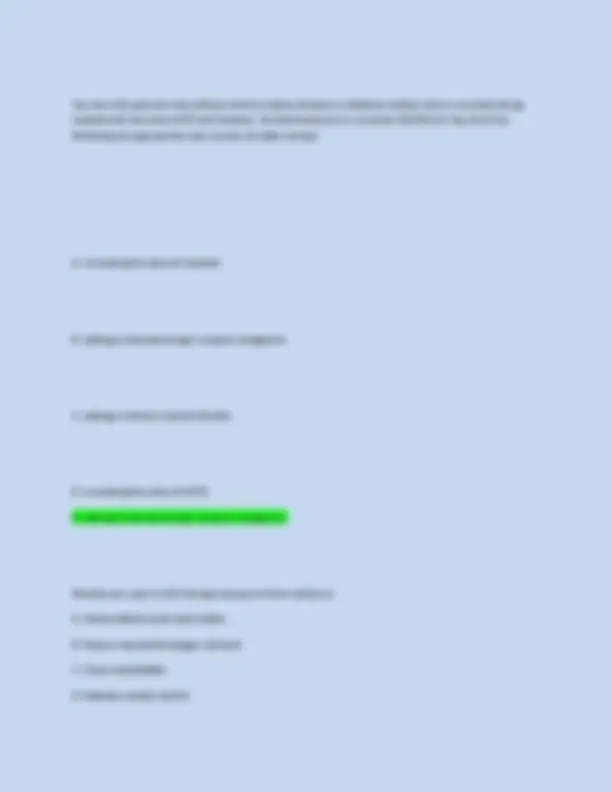
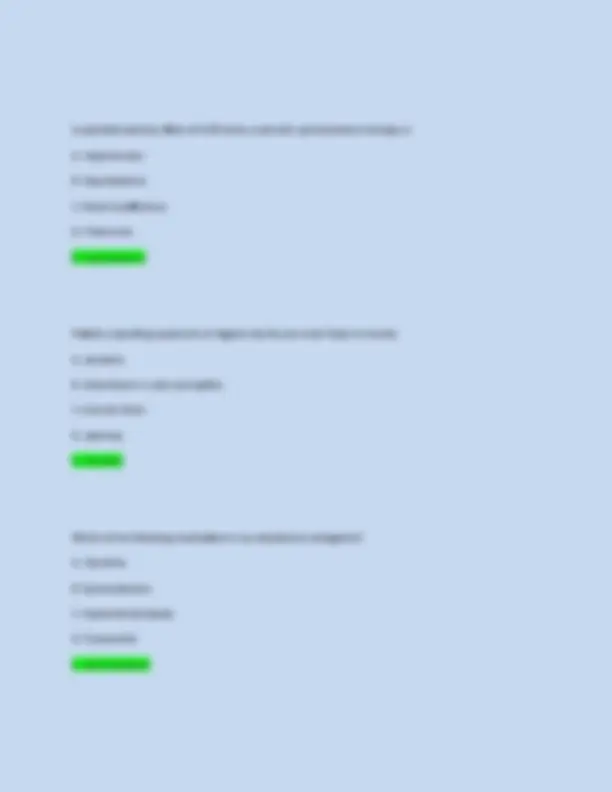
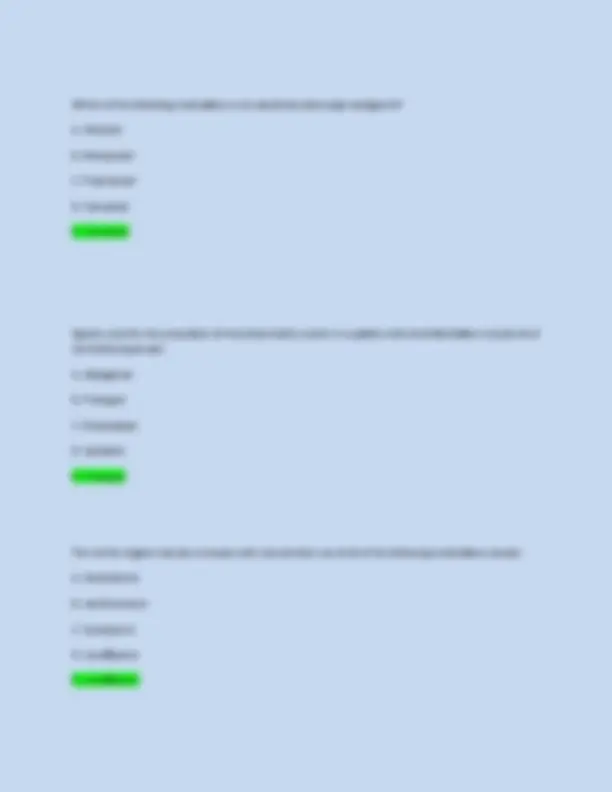
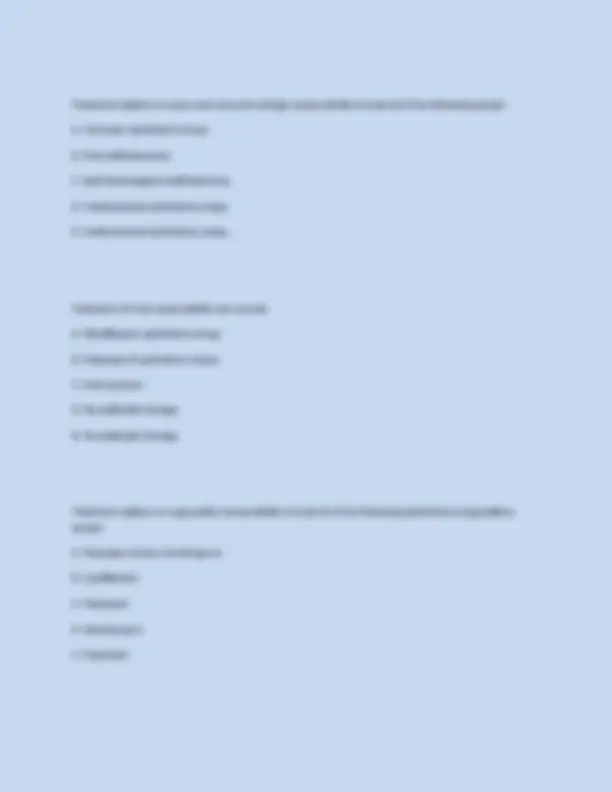
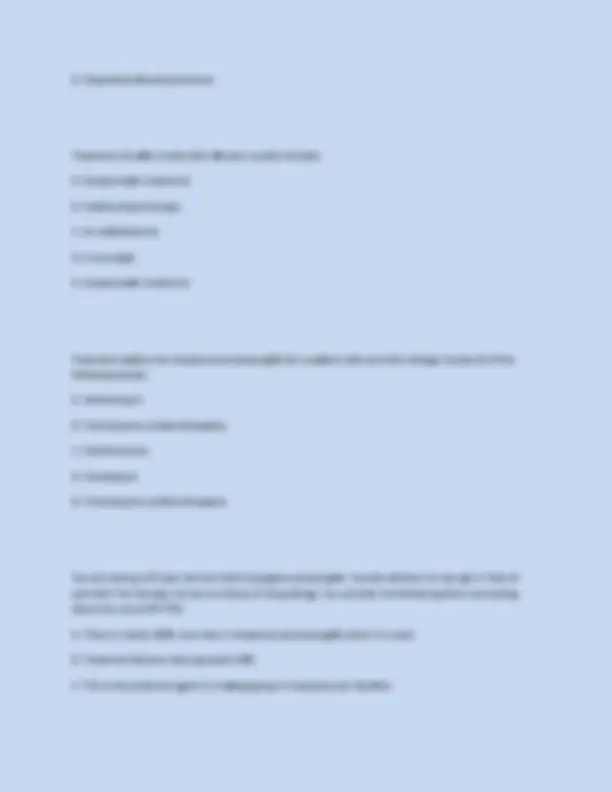
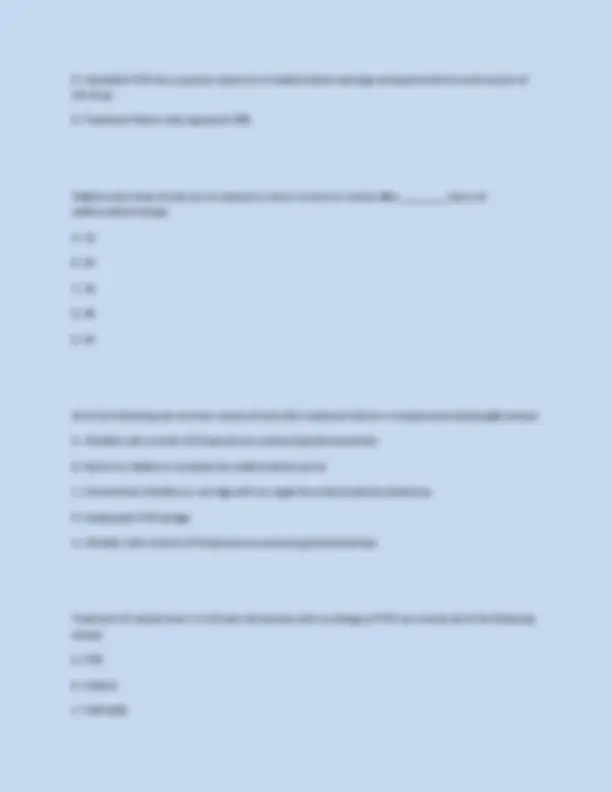
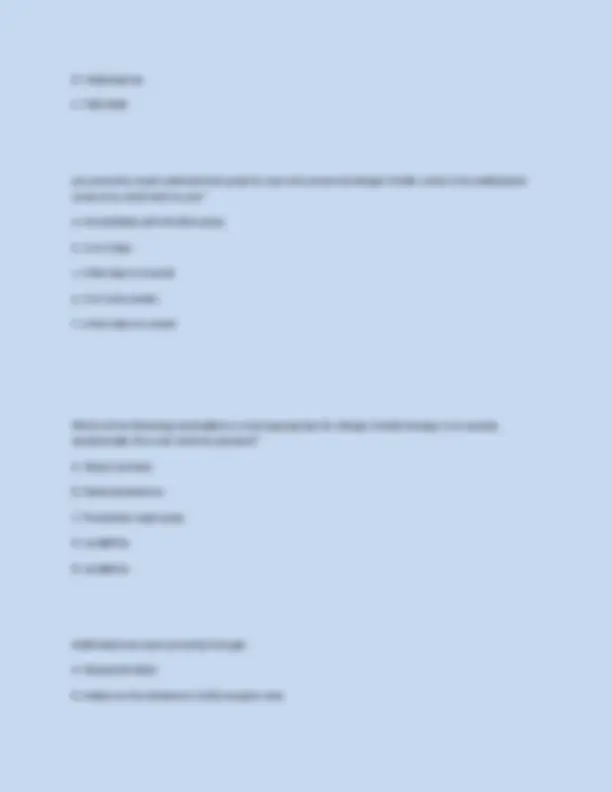
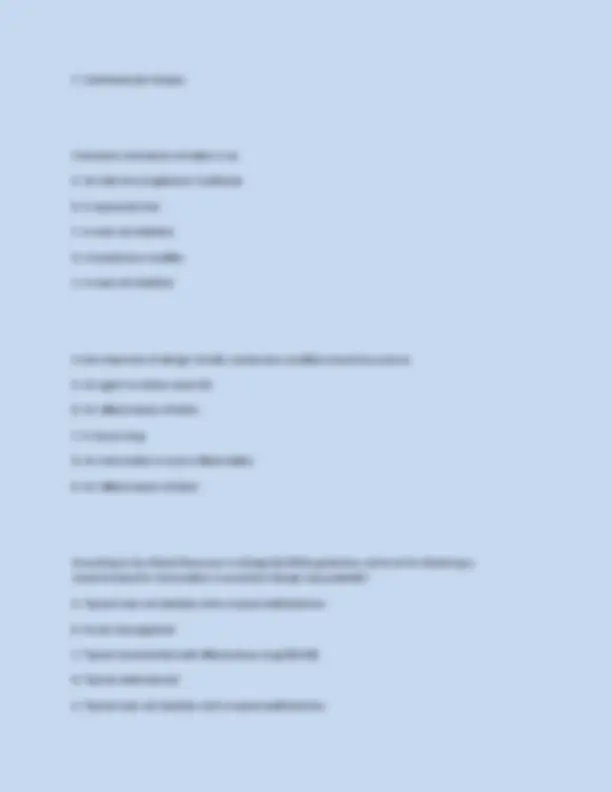
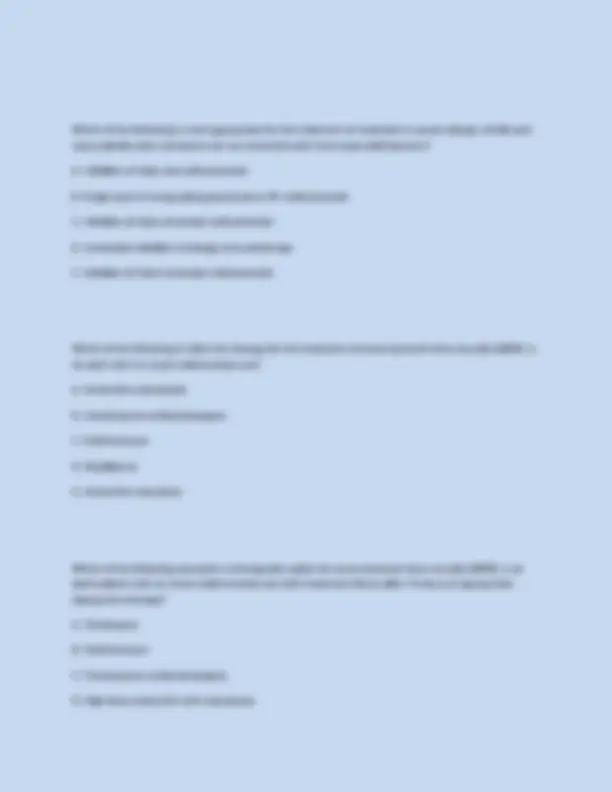
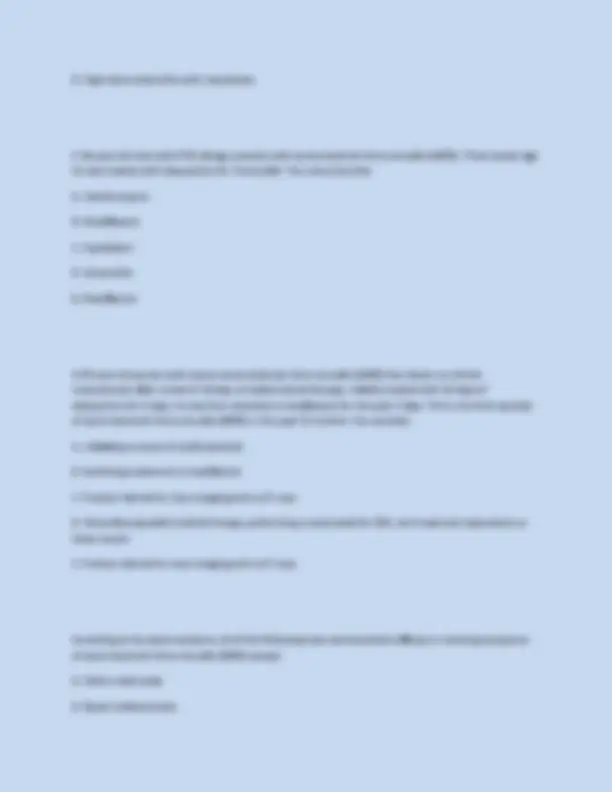
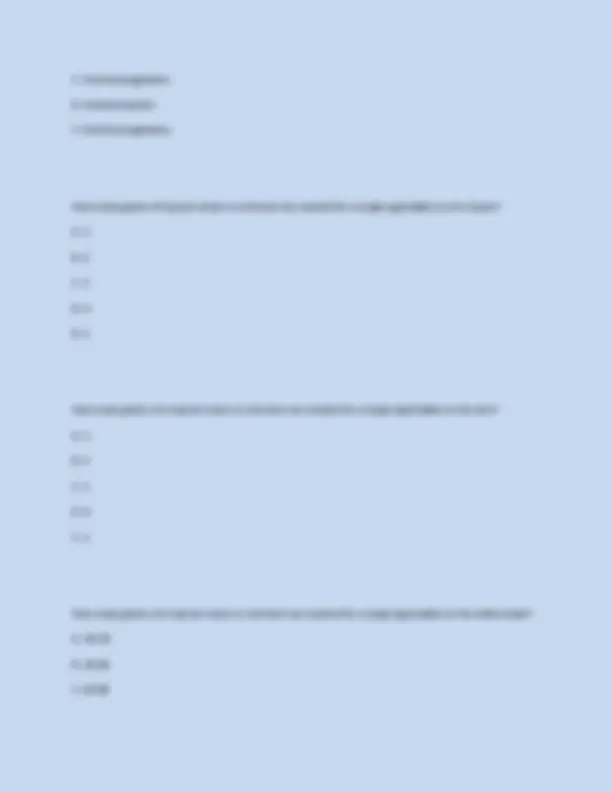
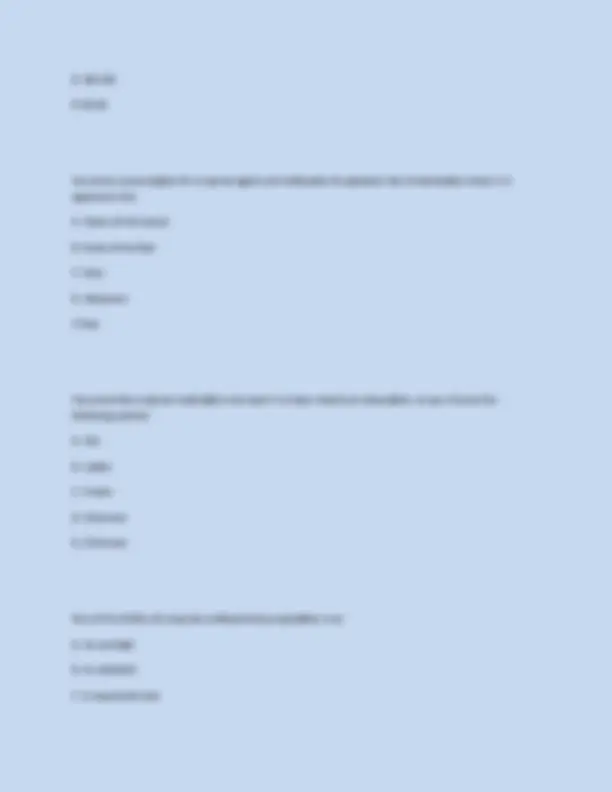
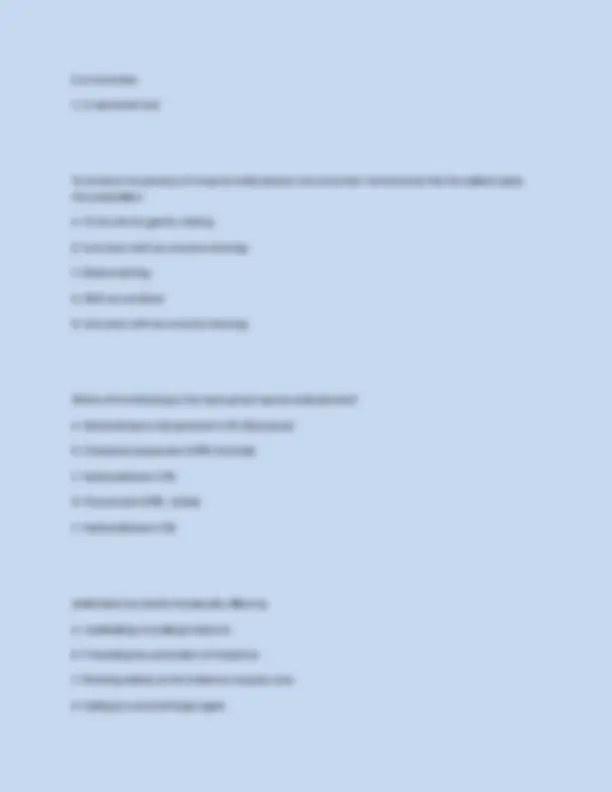
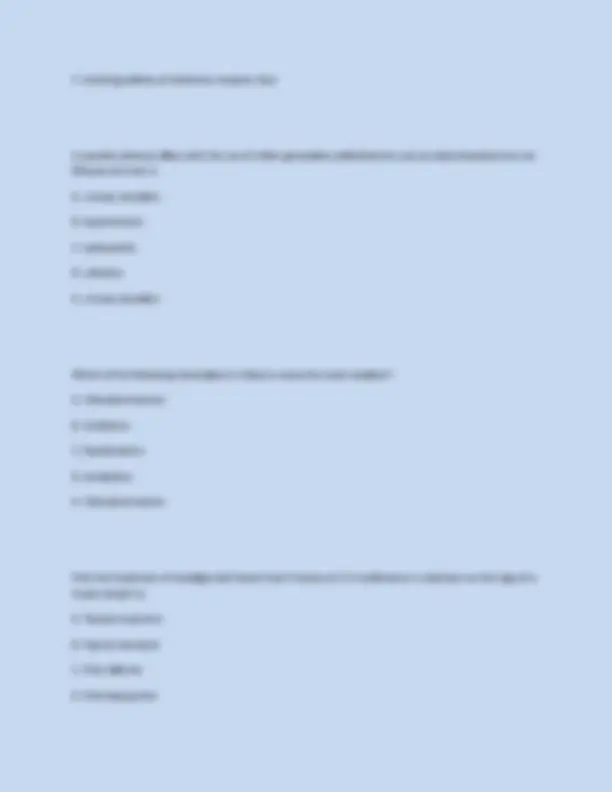
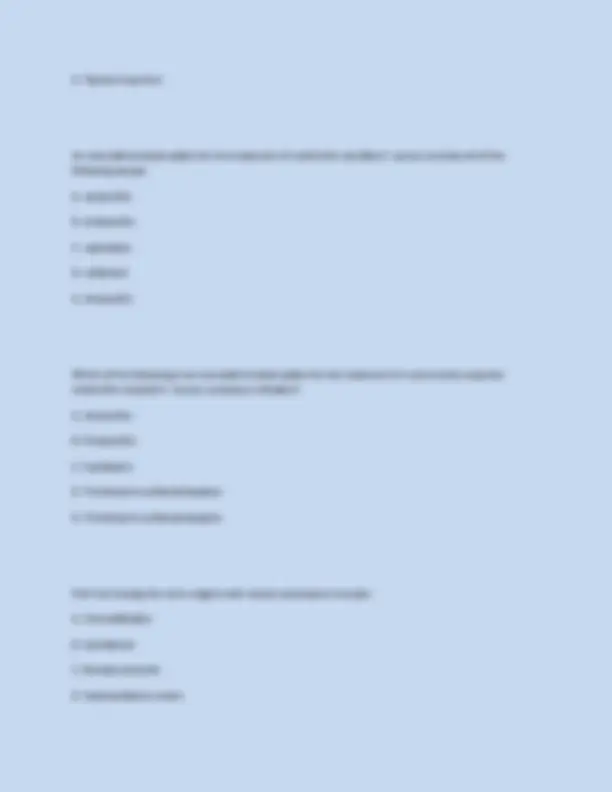
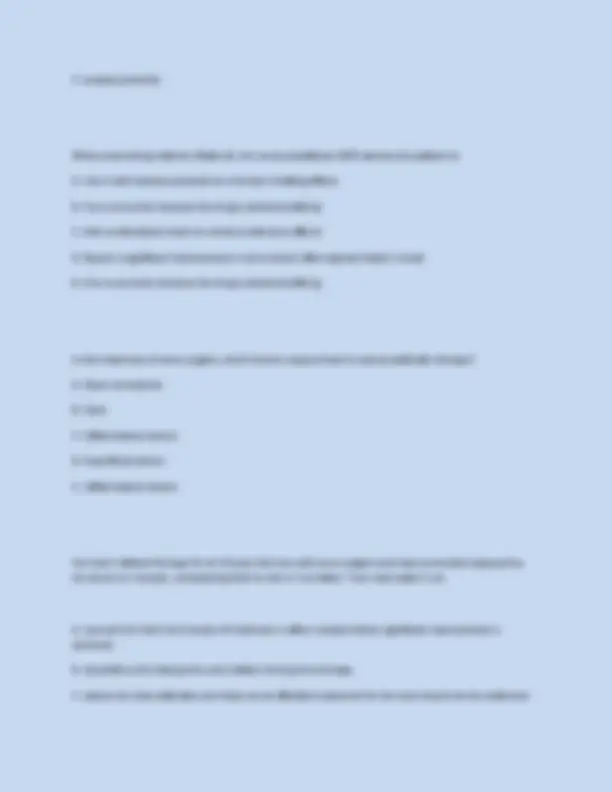
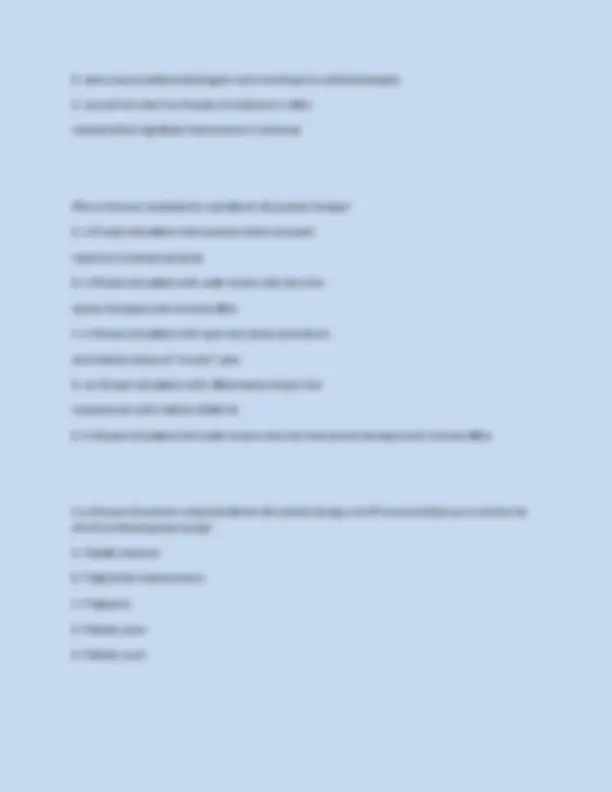
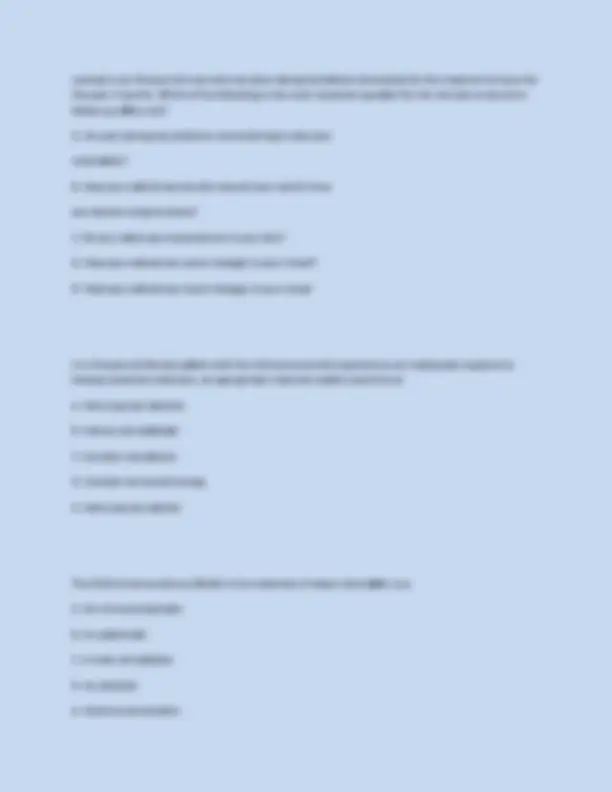
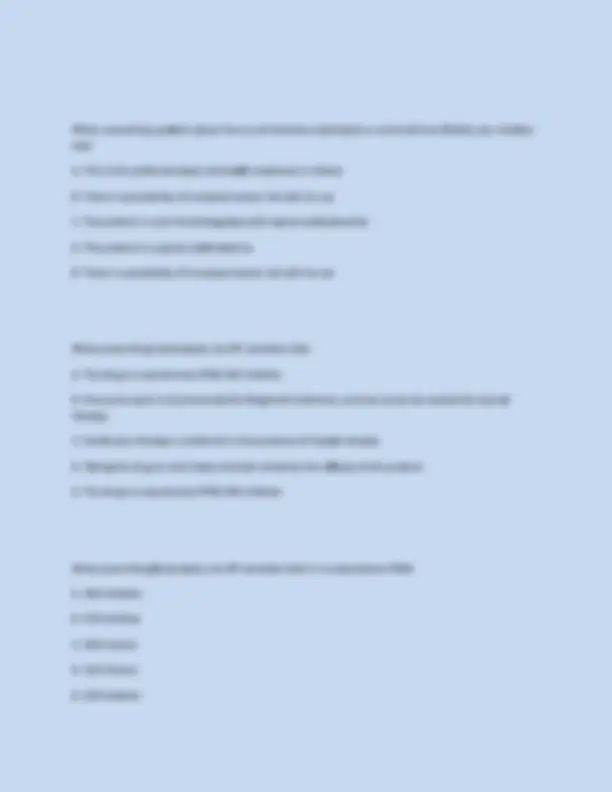


Study with the several resources on Docsity

Earn points by helping other students or get them with a premium plan


Prepare for your exams
Study with the several resources on Docsity

Earn points to download
Earn points by helping other students or get them with a premium plan
Community
Ask the community for help and clear up your study doubts
Discover the best universities in your country according to Docsity users
Free resources
Download our free guides on studying techniques, anxiety management strategies, and thesis advice from Docsity tutors
NURS 540 Test Questions Exam 1 Advanced Health Assessment And Diagnostic Reasoning Exam 2025 Questions And Answers 100% Solved.
Typology: Exams
1 / 29

This page cannot be seen from the preview
Don't miss anything!






















You examine a 38-year-old woman who has presented for an initial examination and Papanicolaou test. She has no complaint. Her blood pressure (BP) is 154/98 mm Hg bilaterally and her body mass index (BMI) is 31 kg/m2. The rest of her physical examination is unremarkable. Your next best action is to:
A. initiate antihypertensive therapy.
B. arrange for at least two additional BP measurements
during the next 2 weeks.
C. order blood urea nitrogen, creatinine, and potassium ion
measurements and urinalysis.
D. advise her to reduce her sodium intake
B. arrange for at least two additional BP measurements
during the next 2 weeks.
You see a 68-year-old woman as a patient who is transferring care into your practice. She has a 10-year history of hypertension, diabetes mellitus, and hyperlipidemia. Current medications include hydrochlorothiazide, glipizide, metformin, simvastatin, and daily low-dose aspirin. Today's BP reading is 158/92 mm Hg, and the rest of her history and examination is unremarkable. Documentation from her former healthcare provider indicates that her BP has been in the range for the past 12 months. Your next best action is to:
A. prescribe an angiotensin-converting enzyme inhibitor (ACEI).
B. have her return for a BP check in 1 week.
C. advise that her current therapy is adequate.
D. add therapy with an aldosterone antagonist.
A. Prescribe an angiotensin-converting enzyme inhibitor (ACEI)
*You see a 38 year old African American male with hypertension who is currently being treated with thiazide-type diuretic. His current blood pressure reading is 156/94 mm Hg and he has no history of diabetes mellitus or chronic kidney disease. Following current best evidence, you consider adding which of the following medications?
a. ACEI
b. angiotensin receptor blocker (ARBs)
c. beta-adrenergic receptor antagonist
d. calcium channel blocker
d. Calcium channel blocker
*According to JNC-8 guidelines, all of the following medications are first-line agents for use in a middle- aged white man without diabetes mellitus except:
a. Lisinopril
b. hydrochlorothiazide
c. metoprolol
d. amlodipine
C. Metoprolol
According to JNC-8, a 52 year old well woman with a healthy BMI whose blood pressure is consistently 130 - 135/82-86 mm Hg is considered to have:
A. Normal Blood Pressure
B. HTN requiring therapy with a CCB
C. HTN requiring therapy with an alpha blocker
D. HTN requiring therapy with a thiazides diuretic
A. Normal Blood Pressure
When compared to caucasians, African Americans tend to have reduced effect with mono therapy with all of the following blood pressure medications except:
A. ACEI
B. ARBs
C. CCB
D. Beta Blockers
C. CCB
You see a 62-year-old man without chronic kidney disease or diabetes mellitus who is currently being treated with low dose HCTZ and losartan. His blood pressure is currently 162/88 mm Hg. All of the following are appropriate next courses of action except:
A. increasing the dose of losartan.
B. adding a beta-adrenergic receptor antagonist.
C. adding a calcium channel blocker.
D. increasing the dose of HCTZ.
B. adding a beta-adrenergic receptor antagonist.
Nitrates are used in ACS therapy because of their ability to:
A. Reverse fixed vessel obstruction
B. Reduce myocardial oxygen demand
C. Cause vasodilation
D. Stabilize cardiac rhythm
B. A dose of NTG via oral spray
Which of the following is an absolute contraindication to use the use of thrombocytes therapy?
A. History of hemorrhagic stroke
B. B/P of 160/100 mm Hg or greater at presentation
C. Current use of warfarin
D. Active peptic ulcer disease
A. History of hemorrhagic stroke
For a patient with a history of MI and who demonstrates intolerance to aspirin, an acceptable alternative anti platelet medication is:
A. Ibuprofen
B. Clopidogrel
C. Warfarin
D. Rivaroxaban
B. Clopidogrel
The rational for using beta blocker therapy in treating a patient with HF is to:
A. Increase myocardial contractility
B. Reduce the effects of circulating catecholamines
C. Relieve concomitant angina
D. Stabilize cardiac rhythm
B. reduce the effects of circulating catecholamines
A potential adverse effect of ACEI when used with spironolactone therapy is:
A. Hypertension
B. Hyperkalemia
C. Renal insufficiency
D. Protenuria
B. Hyperkalemia
Patients reporting symptoms of digoxin toxicity are most likely to include:
A. anorexia.
B. disturbance in color perception.
C. blurred vision.
D. diarrhea.
A. anorexia
Which of the following medications is an aldosterone antagonist?
A. Clonidine
B. Spironolactone
C. Hydrochlorothiazide
D. Furosemide
b. spironolactone
Treatment options in acute and recurrent allergic conjunctivitis include all of the following except:
A. Cromolyn ophthalmic drops.
B. Oral antihistamines.
C. Ophthalmological antihistamines.
D. Corticosteroid ophthalmic drops.
D. Corticosteroid ophthalmic drops.
Treatment of viral conjunctivitis can include:
A. Moxifloxacin ophthalmic drops
B. Polymyxin B ophthalmic drops
C. Oral acyclovir
D. No antibiotic therapy
D. No antibiotic therapy
Treatment options in suppurative conjunctivitis include all of the following ophthalmic preparations except:
A. Polymyxin B plus trimethoprim
B. Levofloxacin
C. Polymyxin
D. Azithromycin
C. Polymyxin
Treatment options for POAG include all of the following topical ocular agents except:
A. Beta-adrenergic antagonists
B. Alpha2-agonists
C. Prostaglandin analogues.
D. Mast Cell Stabilizers
D. Mast Cell Stablizers
A 27 year old woman presents with acute bacterial rhinosinusitis that has failed to respond to 5 days of treatment with amoxicillin. She reports that she experienced an allergic reaction to levofloxacin a few years ago that caused a rash as well as swelling of the lips and tongue. In deciding on new antimicrobial, you consider avoiding the use of:
A. Amoxicillin-clavulanate
B. Azithromycin
C. Moxifloxicin
D.cefpodoxime
C. Moxifloxacin
Appropriate oral antimicrobial therapy for otitis externa with an accompanying facial cellulitis suitable for outpatient therapy includes a course of :
A. Macrolide
B. Cephalosporin
C. Fluroquinolone
D. Penicillin
C. Fluroquinololne
D. Respiratory fluoroquinolones
Treatment of otitis media with effusion usually includes:
A. Symptomatic treatment
B. Antimicrobial therapy
C. An antihistamine
D. A mucolytic
A. Symptomatic treatment
Treatment options for streptococcal pharyngitis for a patient with penicillin allergy include all of the following except:
A. Azithromycin
B. Trimethoprim-sulfamethoxazole
C. Clarithromycin
D. Clindamycin
B. Trimethoprim-sulfamethoxazole
You are seeing a 25 year old man with S pyogenes pharyngitis. He asks whether he can get a "shot of penicillin" for therapy. He has no history of drug allergy. You consider the following when counseling about the use of IM PCN:
A. There is nearly 100% cure rate in streptococcal pharyngitis when it is used.
B. Treatment failures rates approach 20%.
C. This is the preferred agent in treating group G streptococcal infection.
D. Injectable PCN has a superior spectrum of antimicrobial coverage compared with the oral version of the drug.
D. Treatment failure rates approach 20%
Patients with strep throat can be cleared to return to work or school after ________ hours of antimicrobial therapy.
A. 12
B. 24
C. 36
D. 48
B. 24
All of the following are common causes of penicillin treatment failure in streptococcal pharyngitis except:
A. Infection with a strain of Streptococcus-producing beta-lactamase.
B. Failure to initiate or complete the antimicrobial course
C. Concomitant infection or carriage with an organism producing beta-lactamase
D. Inadequate PCN dosage
A. Infection with a strain of Streptococcus-producing beta-lactamase
Treatment of scarlet fever in a 19 year old woman with no allergy to PCN can include all of the following except:
A. PCN
B. Cefdinir
C. TMP-SMX
C. Inflammatory mediation
D peripheral vasodilation
B. Action on the histamine-1 (H1) receptor sites
Decongentants work primarily through:
A. Vasoconstriction
B. Action on the histamine-1 (H1) receptor sites
C. Inflammatory mediation
D. Peripheral vasodilation
A. Vasoconstriction
Which of the following medications affords the best relief of acute nasal itch?
A. Andticholinergic nasal relief
B. Oral decongestant
C. Corticosteroid nasal spray
D. Oral antihistamine
D. Oral antihistamine
According to the American Academy of Otoaryngology-head and neck surgery (AAO-HNS) treatment guidelines, which of the following medications affords the best relief of acute nasal congestion?
A. Anticholinergic nasal spray
B. Oral leukotriene receptor antagonist
C. Oral decongestants
D. Oral antihistamine
C. Oral decongestant
According to AAO-HNS treatment guidelines which of the following is preferred to treat rhinorrhea associated with allergic rhinitis?
A. Anticholinergic nasal spray
B. Oral antihistamine
C. Corticosteroid nasal spray
D. Oral leukotriene receptor antagonist
B. Oral antihistamine
Ipratropium Bromide helps control nasal secretions through:
A. Antihistamine action
B. Anticholinergic effect
C. Vasodilatation
D. Vasoconstriction
B. Anticholinergic effect
Oral decongestant use should be discouraged in patients with:
A. Allergic rhinitis
B. Migraine headache
C. Cardiovascular disease
D. Chronic bronchitis
Which of the following is most appropriate for the treatment of moderate to severe allergic rhinitis and conjunctivitis when symptoms are not controlled with Intra nasal antihistamine?
A. Initiation of daily oral corticosteroids
B. Single dose of a long acting parenteral or IM corticosteroids
C. Initiation of daily intranasal corticosteroids
D. Immediate initiation of allergy immunotherapy
C. Initiation of daily intranasal corticosteroids
Which of the following is a first line therapy for the treatment of acute bacterial rhino-sinusitis (ABRS) in an adult with no recent antimicrobial use?
A. Amoxicillin-clavulanate
B. trimethoprim-sulfamethoxazole
C. Clarithromycin
D. Moxifloxicin
A. Amoxicillin-clavulante
Which of the following represents a therapeutic option for acute bacterial rhino-sinusitis (ABRS) in an adult patient with no recent antimicrobial care with treatment failure after 72 hours of appropriate doxycycline therapy?
A. Clindamycin
B. Clarithromycin
C. Trimethoprim-sulfamethoxazole
D. High-dose amoxicillin with clavulanate
D. High-dose amoxicillin with clavulanate
A 34 year old man with PCN allergy presents with acute bacterial rhino-sinusitis (ABRS). Three weeks ago he was treated with doxycycline for "bronchitis" You now prescribe:
A. Clarithromycin
B. Moxifloxacin
C. Cephalexin
D. Amoxicillin
B. Moxifloxicin
A 45 year old person with severe acute bacterial rhino-sinusitis (ABRS) has shown no clinical improvement after a total of 10 days of antimicrobial therapy. Initially treated with 10 days of doxycycline for 5 days, he was then switched to levofloxacin for the past 5 days. This is his third episode of acute bacterial rhino-sinusitis (ABRS) in the past 12 months. You consider:
A. Initiating a course of corticosteroids
B. Switching treatment to moxifloxicin
C. Prompt referral for sinus imaging with a CT scan
D. Discontinuing antimicrobial therapy, performing a nasal swab for C&S, and treatment dependent on these results
C. Prompt referral for sinus imaging with a CT scan
According to the latest evidence, all of the following have demonstrated efficacy in relieving symptoms of acute bacterial rhino-sinusitis (ABRS) except:
A. Saline nasal spray
B. Nasal corticosteroids